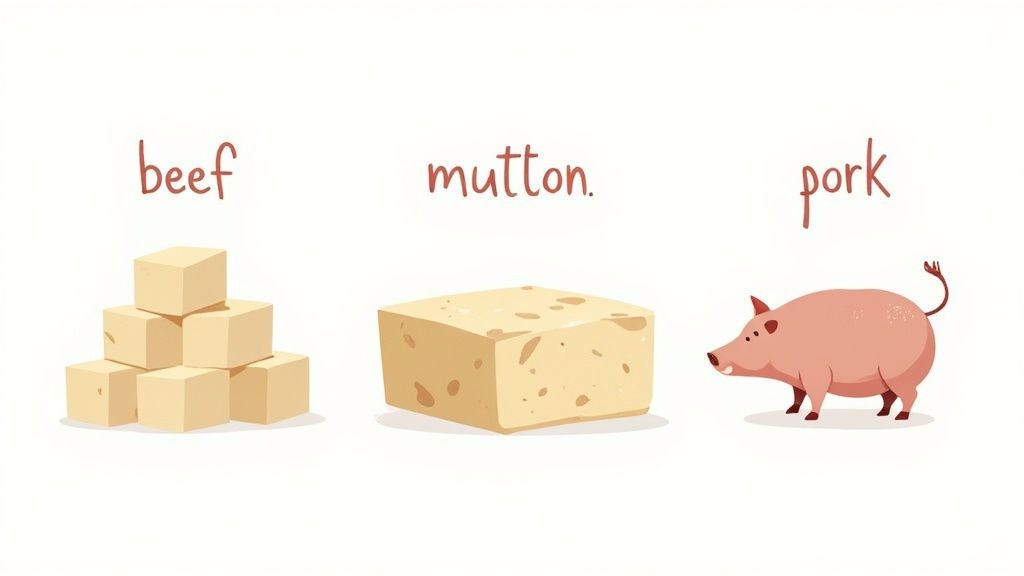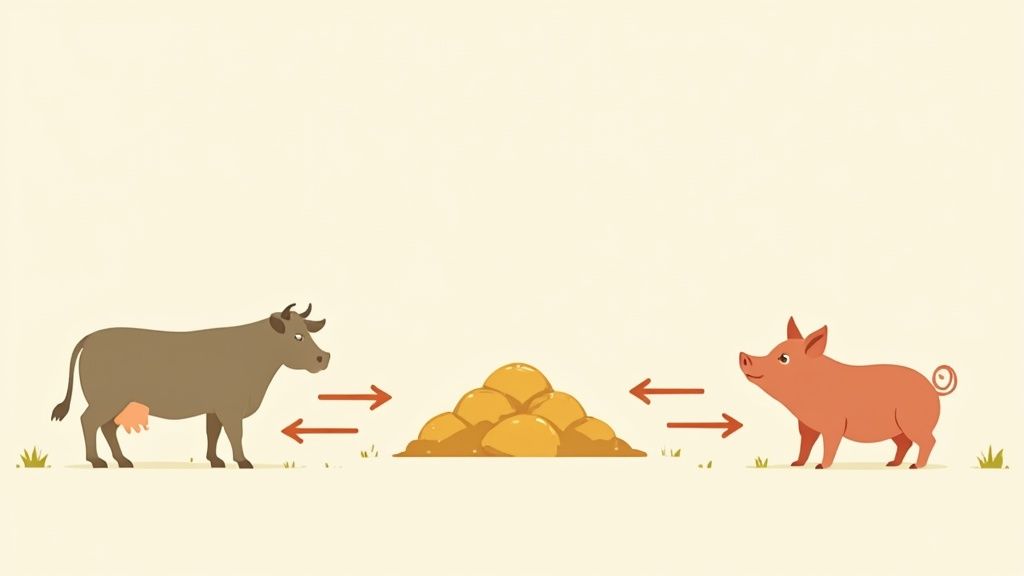So, what exactly is tallow, and where does it come from?
At its heart, tallow is simply a pure, rendered form of animal fat. Its story begins on the farm with a specific type of fat called suet—the hard, nutrient-rich fat found around the kidneys and loins of certain animals, most commonly cattle.
Tracing Tallow From the Farm to Your Home

Think of it this way: suet is the raw material, and tallow is the beautifully finished product. It's a simple, time-honored transformation that unlocks its potential for everything from cooking to skincare.
The process starts with collecting the suet after an animal is processed. This raw fat is then gently heated in a method called "rendering." This slow melting process purifies the fat, separating it from any remaining bits of meat or other impurities.
What’s left is a clean, stable, and incredibly nourishing golden liquid that cools into a creamy solid. That’s tallow.
Let’s quickly break down the key details.
Tallow at a Glance
| Attribute | Description |
|---|---|
| Primary Source | Cattle (beef tallow is the most common) |
| Other Sources | Sheep, deer, and bison |
| Raw Form | Suet (hard fat from around the kidneys and loins) |
| Finished Form | Tallow (the rendered, purified fat) |
This table gives a clear snapshot, but it's the connection to farming that tells the whole story.
Because it’s a natural byproduct of the meat industry, the supply of tallow is tied directly to how we raise livestock. This connection has made it a surprisingly significant global commodity. In 2021, the tallow market was valued at an impressive $7.25 billion, a testament to its widespread use in countless industries. You can learn more about the tallow market dynamics on cognitivemarketresearch.com.
This farm-to-jar journey is precisely why not all tallow is created equal. The way an animal was raised and what it ate has a direct impact on the quality of the final product—a crucial detail we’ll dig into next.
From Raw Fat to Golden Elixir: The Art of Rendering
So, how does that raw, fatty tissue from a cow become the smooth, nourishing tallow in your skincare jar? The magic happens through a time-honored process called rendering.
If you've ever made clarified butter or ghee, you're already familiar with the basic idea. Rendering is all about gently heating the raw suet, which causes the pure fat to melt and separate from everything else—water, proteins, and any other solids.
This slow and careful heating process is what purifies the fat, leaving behind a clean, stable, and remarkably shelf-stable product. It’s a simple but crucial step that unlocks all the goodness locked inside.
The visual below lays out the journey from the farm to the final product.

As you can see, rendering is the key middle step that transforms raw trimmings into the pure tallow we know and love.
Two Paths to Purity
Not all rendering is the same. There are two main ways to do it, and the method chosen can affect the final product's texture, scent, and color. Knowing the difference helps you understand what makes for a truly high-quality tallow.
- Dry Rendering: Think of this as slow-roasting. The chopped fat is heated gently in a heavy pot or oven without any water. As it melts down, you're left with a rich, golden tallow and some delicious crispy bits (called cracklings). This method often produces a more flavorful tallow.
- Wet Rendering: For this technique, the fat is boiled in water or steamed. The melted fat floats to the top and is skimmed off. This process typically results in a whiter, more neutral-smelling tallow, which is often the top choice for creating clean skincare products.
At its core, rendering is about purification. By using heat to remove moisture and solids, we're left with a nutrient-dense fat that’s incredibly resistant to going bad.
For centuries, tallow was a household workhorse, used for everything from candles to soap. Today, its role is expanding. While cattle still account for about 46.3% of the world's tallow supply, its applications are getting more interesting. The fastest-growing demand now comes from biofuels, personal care, and cosmetics, all driven by people seeking out natural, sustainable ingredients. You can discover more insights about the tallow market on grandviewresearch.com to see just how much this traditional fat is making a comeback.
Understanding Grass-Fed vs Grain-Fed Tallow

When it comes to tallow, not all sources are created equal. In fact, the single biggest factor determining its quality is what the animal ate throughout its life. This diet profoundly changes the nutritional makeup of the fat itself.
It helps to remember the old saying: "You are what you eat." This applies just as much to cattle as it does to us. A cow that spends its days grazing on its natural diet of grass produces a fat that is biochemically different—and far more beneficial—than one raised on an unnatural diet of grain.
This is why understanding the distinction between grass-fed and grain-fed is so crucial. It’s not just a marketing gimmick; it’s a clear marker of the tallow’s purity and potency, especially when you’re putting it on your skin.
The Nutritional Advantage of a Natural Diet
Cattle are ruminants, biologically designed to thrive on a diet of grass and forage. When they graze on pasture, their bodies process this natural food and store a powerhouse of nutrients in their fat.
This creates a superior tallow packed with skin-loving compounds. Tallow from grass-fed cattle delivers a significantly better nutritional profile:
- Higher Omega-3 Fatty Acids: Well-known for their potent anti-inflammatory properties, these fatty acids are essential for calming irritated or inflamed skin.
- More Conjugated Linoleic Acid (CLA): This is a powerful fatty acid with demonstrated anti-inflammatory and protective benefits for the skin.
- Increased Fat-Soluble Vitamins: Grass-fed tallow is richer in vitamins A, D, E, and K—all critical nutrients for skin repair, elasticity, and overall health.
A cow's diet directly translates to the quality of its fat. Tallow from grass-fed and grass-finished animals isn't just different—it's biochemically superior, offering a profile of fats and vitamins that is more compatible with our own skin.
Why Grain-Fed Tallow Falls Short
On the other hand, when cattle are fed a diet of grain (most commonly corn and soy), the composition of their fat changes for the worse. This diet is unnatural for them and often leads to systemic inflammation, which ultimately degrades the quality of their suet.
Grain-fed tallow is almost always lower in the beneficial nutrients we just covered and higher in inflammatory omega-6 fatty acids. That beautiful, rich yellow color you see in grass-fed tallow? That comes from its high beta-carotene content (a precursor to Vitamin A) and is typically absent in its pale, lackluster grain-fed counterpart.
For anyone serious about clean, effective skincare, the choice is clear. Sourcing tallow that is 100% grass-fed and grass-finished is absolutely non-negotiable.
To put it all in perspective, here's a direct comparison of the two.
Grass-Fed Tallow vs Grain-Fed Tallow Comparison
This table breaks down the key differences you'll find between tallow sourced from cattle raised on their natural diet versus those fed grain.
| Feature | Grass-Fed Tallow | Grain-Fed Tallow |
|---|---|---|
| Color | Rich, creamy yellow due to high beta-carotene content. | Pale white or off-white, lacking vibrant color. |
| Vitamin Content | Significantly higher in fat-soluble vitamins A, D, E, and K. | Lower concentrations of essential vitamins. |
| Fatty Acid Profile | Higher in anti-inflammatory Omega-3s and CLA. Balanced Omega-3 to Omega-6 ratio. | Higher in pro-inflammatory Omega-6s. An imbalanced and less healthy ratio. |
| Nutrient Density | Dense with a broad spectrum of nutrients that are bioavailable for skin. | Less nutrient-dense and lacks the synergistic benefits of a natural diet. |
| Sourcing Environment | Sourced from cattle raised on open pasture, promoting animal welfare and sustainability. | Often sourced from concentrated animal feeding operations (CAFOs). |
As you can see, the nutritional profile of grass-fed tallow is simply in another league. This superior quality is why it has become the gold standard for creating pure, nourishing, and effective skincare products.
Where Tallow Comes From: More Than Just Cows

When you hear the word “tallow,” your mind probably jumps straight to cows. And you’re not wrong—beef tallow is definitely the most popular and celebrated type, especially in the world of natural skincare. But it’s not the whole story.
Tallow can actually be rendered from the suet (the hard, nutrient-rich fat) of any ruminant animal. This opens up a whole world of traditional fats, from sheep to deer, each with its own unique character.
Different Animals, Different Tallow
Think of it like this: the animal's species and diet are like a recipe that determines the final product. The texture, the scent, the nutrient profile—it all changes depending on the source.
Take mutton tallow, for instance. It's rendered from the suet of adult sheep and tends to be a bit softer than beef tallow. It also carries a distinct, earthy scent that’s very characteristic of lamb or mutton.
These differences boil down to the specific blend of fatty acids. While all tallows are packed with the saturated and monounsaturated fats our skin craves, the exact ratios vary from one animal to another. These subtle shifts influence everything from the tallow's melting point to how it feels when you smooth it onto your skin. You can dive deeper into why this matters by reading about the specific beef tallow benefits for skin.
Key Takeaway: The word tallow almost always refers to fat from ruminants like cows and sheep. It's often confused with lard, but they're not the same. Lard comes specifically from pigs and has a completely different fatty acid profile, making it much softer.
Understanding these nuances makes it clear why beef tallow, especially from grass-fed cattle, has earned its place as the gold standard in skincare. Its balanced, nutrient-dense composition is uniquely compatible with our skin's own biology, making it the perfect base for pure and powerful moisturizers.
How to Choose High-Quality Tallow
Walking down the skincare aisle—or browsing online—can feel a little overwhelming when you're looking for quality tallow. But once you know the language of the labels, it's actually pretty simple to spot the good stuff. Think of it as decoding a secret language that tells you everything you need to know about the purity and power of the product in your hands.
The first and most important distinction to understand is grass-fed vs. grass-finished. It's a subtle difference in wording that has a huge impact on the final product. "Grass-fed" simply means the cow ate grass at some point in its life. But many of these animals are switched to a grain-based diet later on, which fundamentally changes the nutritional quality of their fat.
Decoding the Labels
For the absolute best, you want to see the words 100% grass-fed and grass-finished on the label. This is your guarantee that the animal grazed on its natural diet of grass for its entire life. The result is a far superior fat, loaded with the vitamins and healthy fatty acids our skin loves.
But the animal's diet is only part of the story. Here are a few other terms to look for that signal a truly pure and unprocessed tallow:
- Organic: This is a big one. It means the cattle were raised on certified organic pastures and were never given synthetic hormones, routine antibiotics, or feed treated with chemical pesticides. If you want to dive deeper, we cover this in our guide to organic tallow balm.
- Unbleached: The tallow hasn't been hit with harsh industrial chemicals to make it artificially white. It retains its natural, creamy-yellow hue, which is a great sign—that color comes from a high beta-carotene content passed on from the grass.
- Undeodorized: No high-heat or chemical solvents were used to strip the tallow of its very mild, natural scent. This gentle, minimal-processing approach is crucial for preserving its complete nutrient profile.
The gold standard is pretty straightforward: look for tallow that is 100% grass-fed and grass-finished, organic, unbleached, and rendered from suet. This combination ensures you're getting the purest, most nutrient-dense product possible—the kind of clean skincare that truly works with your body, not against it.
When you choose tallow with these credentials, you're doing more than just buying another moisturizer. You're investing in a clean, ethically-sourced product that is packed with the bioavailable nutrition your skin is designed to recognize and use.
Common Questions About Tallow Sourcing
As you get more familiar with tallow, a few questions always seem to pop up. Let's tackle some of the most common curiosities people have about where it comes from, how to store it, and what to look for.
Is All Tallow Made From Suet Fat?
Not exactly, but the best tallow is. While you can render tallow from any fat on a cow, the highest quality comes exclusively from suet—that hard, crumbly, nutrient-packed fat found around the kidneys and loins.
Tallow from suet is the gold standard. It's purer and has a higher melting point, which makes it perfect for both premium skincare and high-heat cooking.
Tallow rendered from other, softer trimming fats is still usable, but it's often softer and considered lower-grade. It's typically destined for industrial applications or cheaper cooking oils. For the absolute best results in your skincare or kitchen, always check that the label specifies suet tallow.
How Can I Tell If My Tallow Has Gone Bad?
Good news: properly rendered tallow is incredibly stable. Kept at room temperature, it can last for many months, and in the fridge, it can last for over a year. Your nose is your best guide here.
Fresh, high-quality tallow should have a very mild, clean, almost neutral scent, maybe with a faint beefy note. If you open the jar and get a sharp, sour, or crayon-like smell, it's gone rancid and you should toss it. Also, keep an eye out for any obvious mold or strange discoloration.
The real beauty of pure, well-made tallow is its natural stability. Its unique fatty acid structure makes it highly resistant to oxidation, which is why our ancestors relied on it for centuries, long before refrigeration existed.
Can I Make Tallow at Home?
Absolutely! Making your own tallow is a rewarding, time-honored skill, and it's surprisingly simple. The key is to start with high-quality raw suet, which you can often get from a local butcher or a farm that raises grass-fed cattle.
The process is pretty straightforward:
- Chop or Grind: Cut the suet into small, even pieces. Running it through a meat grinder works great if you have one.
- Heat Gently: Put the suet in a slow cooker on low or a heavy-bottomed pot over the lowest possible heat.
- Render Slowly: Let the fat melt down completely. This takes several hours, but the "low and slow" approach is crucial to prevent scorching.
- Strain: Once all the fat has melted, carefully pour the liquid gold through a fine-mesh sieve or a few layers of cheesecloth. This separates the pure tallow from the leftover crispy bits (cracklings).
The beautiful, clear liquid you're left with is pure tallow. Now that you know all about what tallow is used for, having a fresh, homemade supply is even better.
What Is the Difference Between Tallow and Lard?
It all comes down to the animal. Tallow comes from ruminant animals like cows and sheep, while lard comes from pigs.
This difference in origin creates two very different fats. Tallow is rich in saturated fats, giving it that firm, almost waxy texture at room temperature. Lard has more monounsaturated fats, which is why it's much softer and creamier. Both are fantastic traditional fats, but tallow's specific fatty acid profile makes it a uniquely perfect match for our skin.
At Wild Tallow Skincare, we take the guesswork out of sourcing by using only 100% grass-fed, grass-finished suet tallow in every product. Discover the difference that pure, ethical sourcing makes for your skin by exploring our minimalist formulas at https://wildtallow.com.

